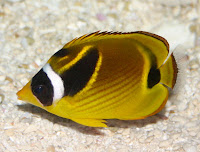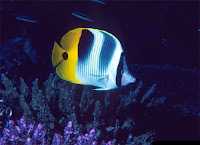Today, butterflyfish are seen as beautiful reef fish both in the wild and in the aquarium. However, the first humans who set eyes on them were far more interested in how good they were to eat.
Butterflyfish are still caught for eating today, but only on a local basis and the numbers are small. Outside their home waters butterflyfish are popular not as food fish, but as aquarium fish. Their dazzling colors and
body patterns, plus the unusual flitting swimming movements that have earned them their name, are the main reasons why they have become popular in aquariums all over the world.Hidden Eyes, False Eyes, and Bony Plates
Many butterflyfish have a dark band that runs from the top of the head, through the eye and onto the chin. This band—or patch—hides the eye from view, and helps to protect it from attack. In addition, many butterflyfish have one or more spots that look like eyes, either on their bodies or the dorsal (back) or caudal (tail) fins. These false eyes or eyespots help draw the attention of attackers away from the real eyes, also helping to protect the fish. The development of young butterflyfish is very interesting. The eggs hatch into a larval stage known as the tholichthys stage.
Tholichthys larvae are covered in tough bony plates that gradually disappear over a period of weeks or months. Juvenile butterflyfish look completely different from adults of the same species. Before scientists realized that this was the case, it was thought that there were many more species of butterflyfish than there actually are.
Tholichthys larvae are covered in tough bony plates that gradually disappear over a period of weeks or months. Juvenile butterflyfish look completely different from adults of the same species. Before scientists realized that this was the case, it was thought that there were many more species of butterflyfish than there actually are.









0 comments:
Post a Comment